- Mar 7, 2024
- 300
- 69
- Origin

- Residence

- Axis Group

The Indian Army’s dash to Dhaka in the 1971 war involved a massive helidrop across the Meghna River. Here’s how it took place.
Prakhar Gupta
Dec 16, 2024, 12:51 PM | Updated Dec 20, 2024, 05:54 PM IST
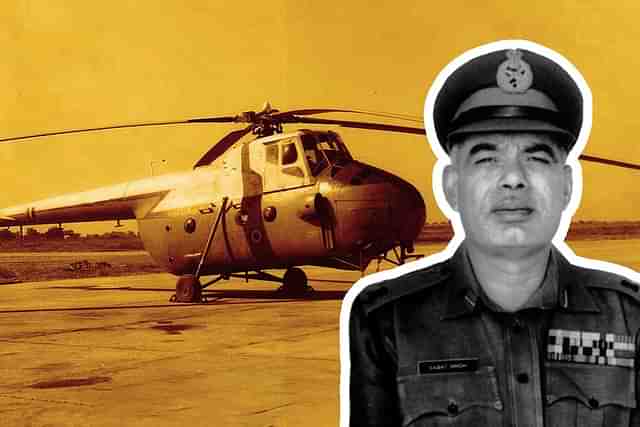
Lieutenant General Sagat Singh and an Indian Mi-4 helicopter.
Unlike most rivers flowing through Bangladesh into the Bay of Bengal, Meghna is not fed by the glaciers in the Himalayas. Still, it is one of it’s mightiest.
The Meghna is formed by the confluence of multiple fast-flowing streams, which descend into the plains of Bangladesh, that barely rise above the sea level, from the rolling hills of eastern India — the area which receives the largest monsoon precipitation in the world.
Consequently, during the monsoon, the river swells, bursts its banks and puts a large part of the country underwater.
As the water recedes, it leaves behind marshy land and perennial lakes, capable of bogging down the most sophisticated military manoeuvres.
As the Indian Army marched into East Pakistan in December 1971, it managed to avoided much of the monsoon swell.
Headquartered in Agartala under Lieutenant General Sagat Singh, a veteran of World War-II and India’s wars with Pakistan and China, the IV Corps of the Indian Army was tasked to move into East Pakistan and secure the areas till the the Meghna River.
The forces under Sagat Singh had to isolate the town Sylhet in north-eastern East Pakistan, and take areas around it, capture Chittagong in the south-east and secure the eastern bank of the Meghna River running north to south.
The IV Corps was closest to Dhaka, the capital of East Pakistan, which was barely 80 km from the Tripura bulge projecting into Pakistani territory.
To bog down Indian forces while it tried to get the United States and China to intervene on its behalf militarily and at the United Nations, the Pakistan Army had occupied nodal points and turned them into fortresses with concrete bunkers. These fortresses were stocked with 45 days of ration and 60 days of ammunition to hold off the Indian Army’s advance for as long as possible.
However, by 8 December, nine days after the war officially began, forces under Sagat Singh were advancing fast towards the Meghna River. The towns of Akhaura, Daukhandi and Chandpur, east of the Meghna, had been captured by his troops after intense fighting, and Sylhet and Chittagong were under siege.
Indian forces had reached close to Ashuganj, which lies on the eastern bank of the Meghna and was one of the nodal points turned into a fortress by the Pakistan Army. The only bridge over the Meghna River, the nearly 3000 feet long Coronation Bridge, was located in Ashuganj and held by Pakistani forces. It was through this bridge that the Indian forces could advance towards Dhaka.
Not tasked to take Dhaka
But when the IV Corps was allocated its tasks, there was no mention of Dhaka. In fact, Dhaka was not spelt out as the objective of the Indian operation.
In a meeting in Tezpur with Lieutenant General Jagjit Singh Aurora, who was the Commander of the Eastern Command during the 1971 war, Sagat Singh had enquired about the tasking for capture of Dacca, as then known. He had been told, Maj Gen Randhir Sinh, his Aide-De-Camp during the war writes in his biography of Sagat Singh, that decision on Dhaka would be taken once the progress of the overall offensive was known.
Another account by Major Chandrakant Singh, who was second in command of the 4 Guards during 1971 war, says that Lieutenant General Aurora had ordered Sagat Singh twice against moving towards Dhaka, as late as 7 and 8 December.
As Major General Sukhwant Singh, who was deputed in September 1971 to tour the formations preparing for offensive into East Pakistan later recalled, Sagat Singh was “not one to be bound by petty constraints”.
Any mention of the opportunity to march to Dhaka “...brought a glint into his eyes....once the battle was joined Sagat Singh was not the one to be bound by petty constraints. He would head the race to Dacca,” he says.
Sagat Singh was “bent on exploiting any fleeting opportunity,” Maj Gen Randhir Sinh writes in Sagat Singh, A Talent for War: The Military Biography of Lt Gen Sagat Singh, adding that he was never fixated on written directives.
Meghna Heli Bridge
With his task east of the Meghna River nearing completion, the opportunity had arrived. Sagat Singh was going to put his forces on the road to Dhaka.
But Ashuganj, where the rail bridge to Dhaka lay, was still under Pakistani control. As Indian forces reached within 150 meters of the Meghna bridge, they came under heavy fire from the Pakistanis. With mounting casualties in absence of significant artillery support, the Indian forces wilted down.
The menacing water of the Meghna threatened to put Dhaka out of the reach of the Indian Army’s IV Corps for long enough to force a military stalemate.
To avoid being bogged down by the Pakistan Army in a costly battle to take Ashuganj and the bridge over Meghna, Sagat Singh decided to airlift his forces across the Meghna to put them on the road to Dhaka.
However, the Pakistan Army, still fearing that the Indian forces will get to the Ashuganj bridge over Meghna at some point, blew it up.
“Engineer resources of the magnitude required to span the river obstacle were not immediately available, and were not likely to be so early enough to keep up the momentum of the advance,” Maj Gen Sukhwant Singh writes.
As Sagat Singh’s task was limited to securing land on the east of the Meghna River, no allocation of inland water transport had been made to his forces.
Preparations for the operation
Before the operation could go ahead, the Indian Army had to find a safe landing zone for the force and equipment that was to be airlifted.
By 7 December, Sagat Singh had already completed preliminary reconnaissance for the heliborne operation to airlift troops across the Meghna.
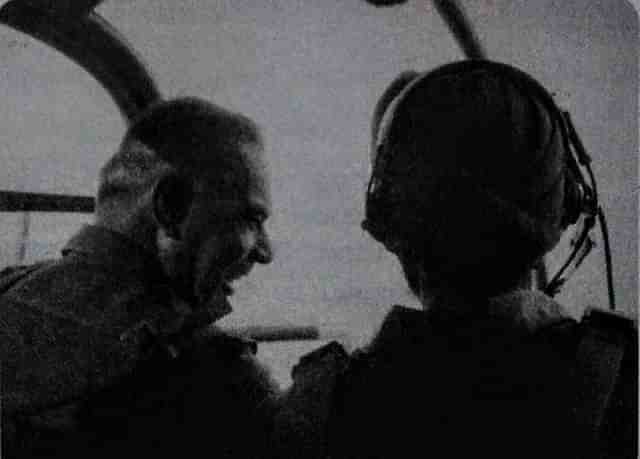
Sagat Singh on aerial reconnaissance. (@SurajPrSingh/X)
On the night of 8 December, he ordered another reconnaissance of the area across the Meghna for a suitable landing zone led by Captain Gurbaksh Singh Sihota.
While flying the reconnaissance mission close to the Meghana bridge with military officers on board, Captain Sihota’s helicopter was targeted by the Pakistanis on the ground with small arms fire. As he scrambled to take the helicopter away from the bridge, he watched it blow up and collapse into the river.
“I had inadvertently come down to 400 feet when we heard the sound of firing. Bullets had gone through the rear of the cockpit and I saw Brig Mishra sitting frozen. Brig Mishra missed losing his head... three bursts of bullets missing his head by no more than three inches,” Sihota, who retired as Lt General, recalls.
Sihota was awarded Vir Chakra for the operation.
On 9 December, as Sihota reached Agartala for an inspection of his helicopter damaged by Pakistani fire, Sagat Singh decided to recce the landing area.
Unaware at this point that the bridge had been blown up, he watched its collapsed span with disappointment. Just moments later, as his helicopter flew lower and closer to the bridge, it was targeted by the Pakistanis by medium machine gun fire.
“...bullets went through the controls and hit Flt Lt Sidhu, the pilot. The passengers sitting behind were splattered by his blood and bone splinters. Sidhu collapsed, the helicopter made a dip but the controls were immediately taken over coolly by Flt Lt Sahi the co-pilot,” Maj Gen Sinh writes.
“...Sagat remained unperturbed, even when a burst shattered the perspex near his head and a bullet grazed his temple like a vermilion mark. He was sitting next to Sahi and half smiling continued to encourage him,” he adds.
Sagat Singh was annoyed and disappointed to find that the enemy had not only blown up the bridge but was still in control of Ashuganj. This made the heliborne operation much more critical for him, and it was to commence by late evening that day.
As enemy interference was expected during the operation from Bhairab Bazaar, a Pakistani-held town on the west bank of the Meghna opposite Ashuganj, most of the operation was to be carried out through the intervening night of 8 and 9 December. The first wave of sorties was to begin just before dusk.
Before the operation began, Sihota went on another reconnaissance mission to “ensure that the Landing Zone was across any distributaries of the Meghna, near the railway line and outside the range of any artillery pieces at Bhairab Bazaar.”
A safe location at a place called Raipur, located nearly 2 km west of the Meghana River, had been selected for the landing of Indian forces.
The operation had to be mounted using the ageing Mi-4 helicopters of the 110 Helicopter Unit of the Indian Air Force. Not all helicopters belonging to this unit were serviceable, and Sagat Singh had to make do with these as the Mi-8s, which he was expecting will arrive in time to replace the Mi-4s, never arrived.
Not just that, the pilots who had to fly the missions across the Meghna carrying troops and equipment had to be qualified for night flying.
4 Gaurds, the unit which was to be flown across the Meghna, had no time to rest and prepare for the herculean operation as it had been pulled out from operations in an area under Pakistani control during its advance towards Ashuganj.
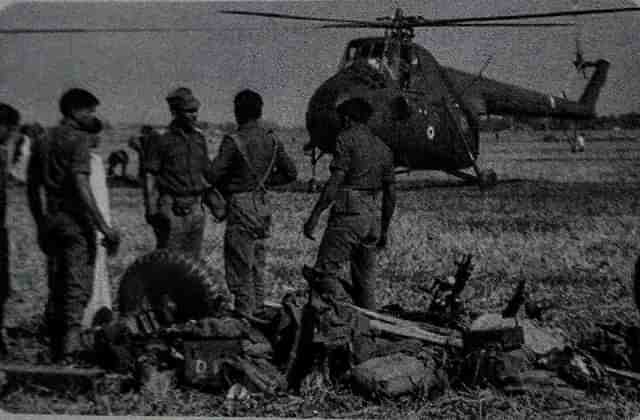
4 Gaurd getting ready to cross the Meghna River. (@SurajPrSingh/X)
First wave and a near disaster
Not just that, he had also lost visual contact with the Mi-4s, and soon realised that they were flying at different altitudes. A disaster was avoided when he improvised, found a new location to land the troops safely and guided the Mi-4s to land at the spot.
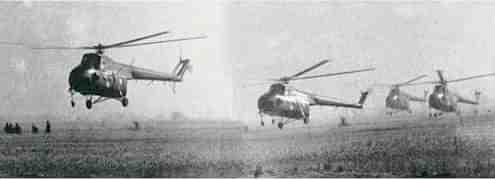
Mi-4 of IAF mounting troops in Brahmanbaria on 9 December 1971.
“As soon as they [Mi-4s] had done so [landed] he [Sihota] took off and headed back to Teliamura. He was in a cold sweat and did not 'sleep the whole night', any moment expecting some news of disaster,” writes Maj Gen Sinh.
No bad news arrived.
“There was some desultory shelling but as most of the shells were landing a km away, the enemy soon gave that up,” Maj Gen Sinh adds.
The helicopters had to land in the dark as lighting up the landing zone would have given away the location of the incoming troops instantly, inviting immediate and focused counter from the Pakistani forces on the ground.
But the ingenuity of the pilots and those assisting them on the ground helped. They formed the letter ‘H’, representing the helipad, with hand-held torch lights. The reflector of the torches had been removed to minimize the glare at the pilot’s eye. This arrangement produced just enough light to guide the pilots to land safely.
By 4:30 pm, the 4 Guards unit had landed at Raipur, without resistance from the enemy, and forces continued to fly in till 3 am.
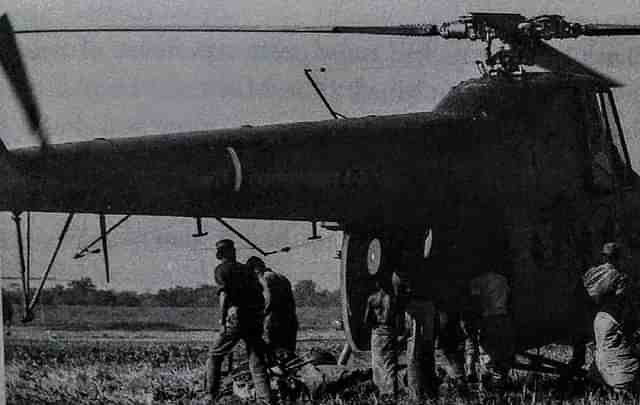
Heli landing across the Meghna River. (@SurajPrSingh/X)
“Nobody looked at the charts to see what we can carry, we just filled up the helicopter and coaxed it to get airborne, very fortunate we had no accidents. We were overloaded most of the time. I can tell you MI-4 never let us down – what a wonderful workhorse,” Squadron Leader Pushp Kumar Vaid, who flew nearly three dozen missions as Flight Lieutenant in such hazardous conditions and was awarded Vir Chakra for it, writes.
Over the next 36 hours, 409 sorties were carried out, and around 5,000 troops and 51 tonnes of equipment had been heli-lifted through the air-bridge.
As Maj Gen Sinh writes, Sagat Singh, “through sheer dint of his personality and at times brutal goading”, had managed to push Indian forces across the mighty Meghna, “an obstacle considered impassable by the sanguine Niazi”.
If not for Sagat Singh, the war may not have ended the way it did — as the swiftest and the most decisive victory in India’s recent military history.
Prakhar Gupta
Dec 16, 2024, 12:51 PM | Updated Dec 20, 2024, 05:54 PM IST

Lieutenant General Sagat Singh and an Indian Mi-4 helicopter.
Unlike most rivers flowing through Bangladesh into the Bay of Bengal, Meghna is not fed by the glaciers in the Himalayas. Still, it is one of it’s mightiest.
The Meghna is formed by the confluence of multiple fast-flowing streams, which descend into the plains of Bangladesh, that barely rise above the sea level, from the rolling hills of eastern India — the area which receives the largest monsoon precipitation in the world.
Consequently, during the monsoon, the river swells, bursts its banks and puts a large part of the country underwater.
As the water recedes, it leaves behind marshy land and perennial lakes, capable of bogging down the most sophisticated military manoeuvres.
As the Indian Army marched into East Pakistan in December 1971, it managed to avoided much of the monsoon swell.
Headquartered in Agartala under Lieutenant General Sagat Singh, a veteran of World War-II and India’s wars with Pakistan and China, the IV Corps of the Indian Army was tasked to move into East Pakistan and secure the areas till the the Meghna River.
The forces under Sagat Singh had to isolate the town Sylhet in north-eastern East Pakistan, and take areas around it, capture Chittagong in the south-east and secure the eastern bank of the Meghna River running north to south.
The IV Corps was closest to Dhaka, the capital of East Pakistan, which was barely 80 km from the Tripura bulge projecting into Pakistani territory.
To bog down Indian forces while it tried to get the United States and China to intervene on its behalf militarily and at the United Nations, the Pakistan Army had occupied nodal points and turned them into fortresses with concrete bunkers. These fortresses were stocked with 45 days of ration and 60 days of ammunition to hold off the Indian Army’s advance for as long as possible.
However, by 8 December, nine days after the war officially began, forces under Sagat Singh were advancing fast towards the Meghna River. The towns of Akhaura, Daukhandi and Chandpur, east of the Meghna, had been captured by his troops after intense fighting, and Sylhet and Chittagong were under siege.
Indian forces had reached close to Ashuganj, which lies on the eastern bank of the Meghna and was one of the nodal points turned into a fortress by the Pakistan Army. The only bridge over the Meghna River, the nearly 3000 feet long Coronation Bridge, was located in Ashuganj and held by Pakistani forces. It was through this bridge that the Indian forces could advance towards Dhaka.
Not tasked to take Dhaka
But when the IV Corps was allocated its tasks, there was no mention of Dhaka. In fact, Dhaka was not spelt out as the objective of the Indian operation.
In a meeting in Tezpur with Lieutenant General Jagjit Singh Aurora, who was the Commander of the Eastern Command during the 1971 war, Sagat Singh had enquired about the tasking for capture of Dacca, as then known. He had been told, Maj Gen Randhir Sinh, his Aide-De-Camp during the war writes in his biography of Sagat Singh, that decision on Dhaka would be taken once the progress of the overall offensive was known.
Another account by Major Chandrakant Singh, who was second in command of the 4 Guards during 1971 war, says that Lieutenant General Aurora had ordered Sagat Singh twice against moving towards Dhaka, as late as 7 and 8 December.
As Major General Sukhwant Singh, who was deputed in September 1971 to tour the formations preparing for offensive into East Pakistan later recalled, Sagat Singh was “not one to be bound by petty constraints”.
Any mention of the opportunity to march to Dhaka “...brought a glint into his eyes....once the battle was joined Sagat Singh was not the one to be bound by petty constraints. He would head the race to Dacca,” he says.
Sagat Singh was “bent on exploiting any fleeting opportunity,” Maj Gen Randhir Sinh writes in Sagat Singh, A Talent for War: The Military Biography of Lt Gen Sagat Singh, adding that he was never fixated on written directives.
Meghna Heli Bridge
With his task east of the Meghna River nearing completion, the opportunity had arrived. Sagat Singh was going to put his forces on the road to Dhaka.
But Ashuganj, where the rail bridge to Dhaka lay, was still under Pakistani control. As Indian forces reached within 150 meters of the Meghna bridge, they came under heavy fire from the Pakistanis. With mounting casualties in absence of significant artillery support, the Indian forces wilted down.
The menacing water of the Meghna threatened to put Dhaka out of the reach of the Indian Army’s IV Corps for long enough to force a military stalemate.
To avoid being bogged down by the Pakistan Army in a costly battle to take Ashuganj and the bridge over Meghna, Sagat Singh decided to airlift his forces across the Meghna to put them on the road to Dhaka.
However, the Pakistan Army, still fearing that the Indian forces will get to the Ashuganj bridge over Meghna at some point, blew it up.
“Engineer resources of the magnitude required to span the river obstacle were not immediately available, and were not likely to be so early enough to keep up the momentum of the advance,” Maj Gen Sukhwant Singh writes.
As Sagat Singh’s task was limited to securing land on the east of the Meghna River, no allocation of inland water transport had been made to his forces.
Preparations for the operation
Before the operation could go ahead, the Indian Army had to find a safe landing zone for the force and equipment that was to be airlifted.
By 7 December, Sagat Singh had already completed preliminary reconnaissance for the heliborne operation to airlift troops across the Meghna.

Sagat Singh on aerial reconnaissance. (@SurajPrSingh/X)
On the night of 8 December, he ordered another reconnaissance of the area across the Meghna for a suitable landing zone led by Captain Gurbaksh Singh Sihota.
While flying the reconnaissance mission close to the Meghana bridge with military officers on board, Captain Sihota’s helicopter was targeted by the Pakistanis on the ground with small arms fire. As he scrambled to take the helicopter away from the bridge, he watched it blow up and collapse into the river.
“I had inadvertently come down to 400 feet when we heard the sound of firing. Bullets had gone through the rear of the cockpit and I saw Brig Mishra sitting frozen. Brig Mishra missed losing his head... three bursts of bullets missing his head by no more than three inches,” Sihota, who retired as Lt General, recalls.
Sihota was awarded Vir Chakra for the operation.
On 9 December, as Sihota reached Agartala for an inspection of his helicopter damaged by Pakistani fire, Sagat Singh decided to recce the landing area.
Unaware at this point that the bridge had been blown up, he watched its collapsed span with disappointment. Just moments later, as his helicopter flew lower and closer to the bridge, it was targeted by the Pakistanis by medium machine gun fire.
“...bullets went through the controls and hit Flt Lt Sidhu, the pilot. The passengers sitting behind were splattered by his blood and bone splinters. Sidhu collapsed, the helicopter made a dip but the controls were immediately taken over coolly by Flt Lt Sahi the co-pilot,” Maj Gen Sinh writes.
“...Sagat remained unperturbed, even when a burst shattered the perspex near his head and a bullet grazed his temple like a vermilion mark. He was sitting next to Sahi and half smiling continued to encourage him,” he adds.
Sagat Singh was annoyed and disappointed to find that the enemy had not only blown up the bridge but was still in control of Ashuganj. This made the heliborne operation much more critical for him, and it was to commence by late evening that day.
As enemy interference was expected during the operation from Bhairab Bazaar, a Pakistani-held town on the west bank of the Meghna opposite Ashuganj, most of the operation was to be carried out through the intervening night of 8 and 9 December. The first wave of sorties was to begin just before dusk.
Before the operation began, Sihota went on another reconnaissance mission to “ensure that the Landing Zone was across any distributaries of the Meghna, near the railway line and outside the range of any artillery pieces at Bhairab Bazaar.”
A safe location at a place called Raipur, located nearly 2 km west of the Meghana River, had been selected for the landing of Indian forces.
The operation had to be mounted using the ageing Mi-4 helicopters of the 110 Helicopter Unit of the Indian Air Force. Not all helicopters belonging to this unit were serviceable, and Sagat Singh had to make do with these as the Mi-8s, which he was expecting will arrive in time to replace the Mi-4s, never arrived.
Not just that, the pilots who had to fly the missions across the Meghna carrying troops and equipment had to be qualified for night flying.
4 Gaurds, the unit which was to be flown across the Meghna, had no time to rest and prepare for the herculean operation as it had been pulled out from operations in an area under Pakistani control during its advance towards Ashuganj.

4 Gaurd getting ready to cross the Meghna River. (@SurajPrSingh/X)
First wave and a near disaster
Not just that, he had also lost visual contact with the Mi-4s, and soon realised that they were flying at different altitudes. A disaster was avoided when he improvised, found a new location to land the troops safely and guided the Mi-4s to land at the spot.

Mi-4 of IAF mounting troops in Brahmanbaria on 9 December 1971.
“As soon as they [Mi-4s] had done so [landed] he [Sihota] took off and headed back to Teliamura. He was in a cold sweat and did not 'sleep the whole night', any moment expecting some news of disaster,” writes Maj Gen Sinh.
No bad news arrived.
“There was some desultory shelling but as most of the shells were landing a km away, the enemy soon gave that up,” Maj Gen Sinh adds.
The helicopters had to land in the dark as lighting up the landing zone would have given away the location of the incoming troops instantly, inviting immediate and focused counter from the Pakistani forces on the ground.
But the ingenuity of the pilots and those assisting them on the ground helped. They formed the letter ‘H’, representing the helipad, with hand-held torch lights. The reflector of the torches had been removed to minimize the glare at the pilot’s eye. This arrangement produced just enough light to guide the pilots to land safely.
By 4:30 pm, the 4 Guards unit had landed at Raipur, without resistance from the enemy, and forces continued to fly in till 3 am.

Heli landing across the Meghna River. (@SurajPrSingh/X)
“Nobody looked at the charts to see what we can carry, we just filled up the helicopter and coaxed it to get airborne, very fortunate we had no accidents. We were overloaded most of the time. I can tell you MI-4 never let us down – what a wonderful workhorse,” Squadron Leader Pushp Kumar Vaid, who flew nearly three dozen missions as Flight Lieutenant in such hazardous conditions and was awarded Vir Chakra for it, writes.
Over the next 36 hours, 409 sorties were carried out, and around 5,000 troops and 51 tonnes of equipment had been heli-lifted through the air-bridge.
As Maj Gen Sinh writes, Sagat Singh, “through sheer dint of his personality and at times brutal goading”, had managed to push Indian forces across the mighty Meghna, “an obstacle considered impassable by the sanguine Niazi”.
If not for Sagat Singh, the war may not have ended the way it did — as the swiftest and the most decisive victory in India’s recent military history.


